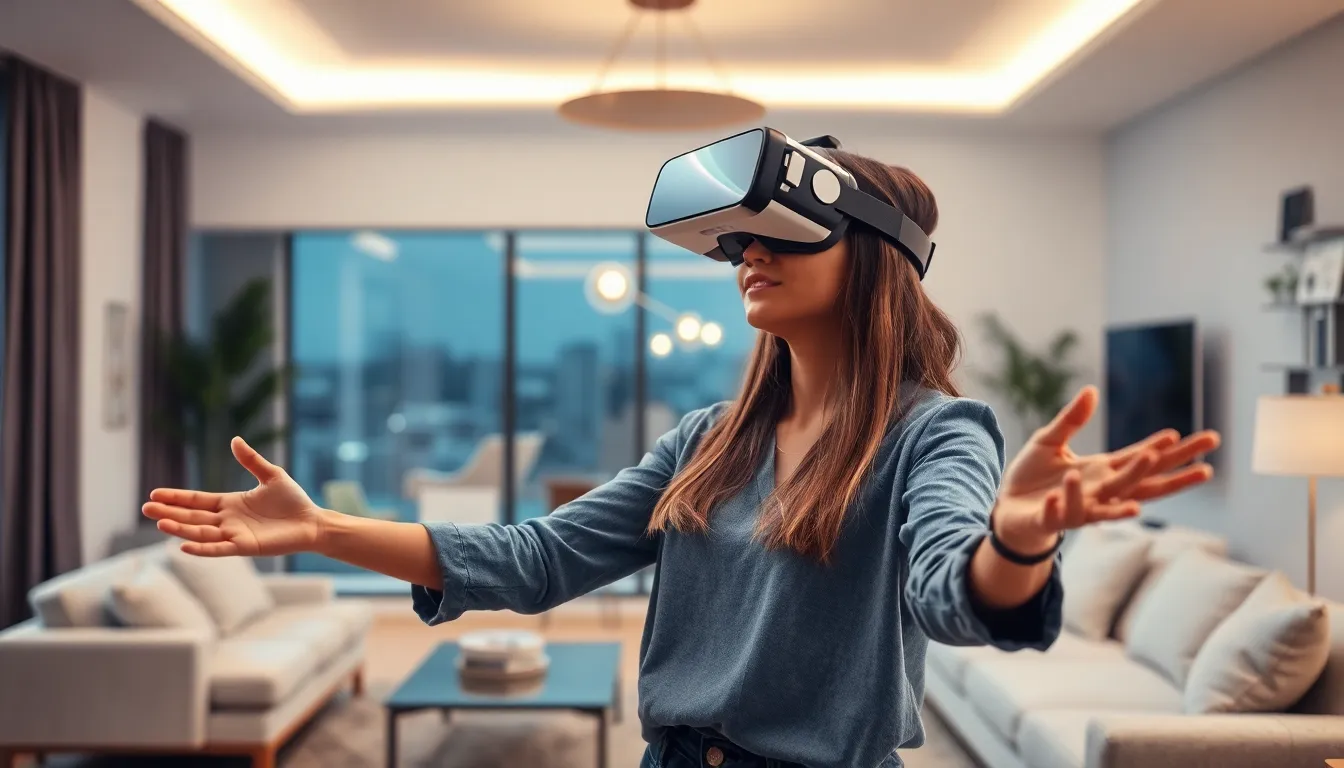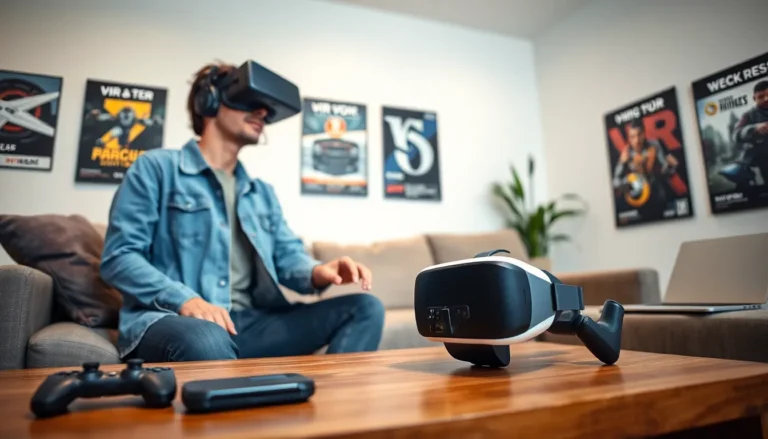Imagine slipping on a headset and suddenly finding yourself in a world where gravity is optional and dragons are your new best friends. Welcome to virtual reality, where the only limit is your imagination. This technology isn’t just for gamers anymore; it’s revolutionizing how we learn, socialize, and even experience art.
Table of Contents
ToggleWhat Is Virtual Reality?
Virtual reality (VR) creates a simulated environment that can mimic the real world or offer entirely new experiences. Users interact with this environment through specialized equipment, such as headsets and motion controllers. This technology immerses users, making them feel present in a different space.
VR applications extend far beyond gaming. In education, students can explore ancient civilizations or conduct virtual lab experiments, enhancing understanding through experiential learning. Healthcare professionals utilize VR for training simulations, allowing them to practice intricate procedures without real-life consequences.
Social interactions also benefit from VR’s immersive capabilities. Virtual gatherings enable individuals to connect with others worldwide in shared digital spaces, broadening communication opportunities. Artists harness VR to craft unique experiences, merging creativity with technology to engage audiences in novel ways.
Platforms like Oculus Rift, HTC Vive, and PlayStation VR illustrate the market’s growth and accessibility. Various genres, including adventure, horror, and simulation, appeal to wide-ranging interests, attracting diverse users.
Statistics reveal significant growth potential in the VR industry, with revenues projected to reach $44.7 billion by 2024. This rapid expansion reflects increased investment and innovation. As a result, VR continues to evolve, fostering advancements in technology and broader applications across multiple fields.
Adopting VR technology transforms experiences and interactions, seamlessly blending the physical and virtual realms. Additionally, ongoing research examines the psychological effects of VR, ensuring its responsible use. This immersive environment promises boundless possibilities, equally enriching education, entertainment, and artistic expression.
Applications of Virtual Reality

Virtual reality provides diverse applications across multiple sectors, transforming conventional methods into immersive experiences.
Gaming and Entertainment
Gaming remains the most prominent application of virtual reality. Players immerse themselves in richly detailed worlds, enhancing engagement levels through realistic interactions. Titles like “Beat Saber” and “Half-Life: Alyx” showcase the medium’s potential, captivating audiences and creating memorable experiences. The entertainment industry also leverages VR for virtual concerts and events, allowing participants to enjoy live performances from home while experiencing a sense of presence.
Education and Training
Education benefits significantly from virtual reality technology. Students explore historical sites and complex scientific concepts through interactive lessons, making learning more engaging. Virtual field trips allow learners to visit places like the Parthenon or Mars without leaving their classrooms. Furthermore, vocational training utilizes VR for simulations, offering safe environments for practice. Trainees can hone skills in areas like aviation and manufacturing without real-world risks, ensuring they are better prepared for actual tasks.
Healthcare
Healthcare applications of virtual reality advance both training and patient care. Medical students practice surgical procedures via realistic simulations, improving their skills before encountering real patients. Pain management techniques utilize VR to distract patients during procedures, leading to reduced anxiety and pain perception. Additionally, exposure therapy for phobias benefits from VR environments that gradually introduce patients to their fears in controlled settings, fostering effective treatment and recovery.
Benefits of Virtual Reality
Virtual reality (VR) offers numerous advantages across various sectors. Enhanced experiences and improved outcomes showcase its potential.
Enhanced Immersion
Immersion defines VR’s primary advantage. Users experience realistic environments that engage multiple senses. It fosters deeper emotional connections in gaming and storytelling, elevating enjoyment. In entertainment, interactions with digital spaces create memorable moments. For example, VR concerts provide attendees with front-row experiences without leaving home. This level of engagement goes beyond traditional formats, making users feel present in the action. Such capabilities appeal to diverse audiences, enhancing market reach. Businesses leverage this immersion to captivate customers, ensuring lasting impressions. Enhanced immersion ultimately transforms perceptions of reality and virtual environments, providing endless possibilities.
Improved Learning Outcomes
Learning outcomes significantly improve with VR integration. Interactive experiences make complex subjects easier to grasp. Students exploring historical events or scientific concepts become active participants in education. This engagement fosters retention and comprehension, leading to higher academic performance. Research shows that VR learners outperform traditional methods by 76%. Such dramatic differences highlight the technology’s impact on education. Additionally, the risk-free environments for vocational training allow practice of critical skills. In healthcare, for instance, medical students refine surgical techniques within simulated settings. Improved learning outcomes ultimately equip individuals with essential skills while preparing them for real-world applications.
Challenges and Limitations of Virtual Reality
Virtual reality faces various challenges and limitations that affect its widespread adoption and effectiveness.
Technical Constraints
Technical constraints pose significant barriers in the development and use of VR technologies. High-quality headsets require substantial processing power, resulting in expensive hardware that limits accessibility. Another challenge stems from motion sickness experienced by some users during immersive experiences. Limitations in tracking technology can also hinder user movement, affecting immersion. Additionally, content availability remains an issue, as many applications still need to be developed for important sectors like education and healthcare. Bandwidth requirements for sophisticated virtual experiences further complicate deployment, particularly in areas with slow internet connections.
Ethical Considerations
Ethical considerations are crucial when examining the effects of virtual reality. Privacy concerns arise from data collection necessary for personalized experiences. Users often share sensitive information, raising questions about data security and potential misuse. Psychological impacts warrant attention, as prolonged exposure to virtual environments can influence mental health. Another ethical dilemma involves content sensitivity, particularly in gaming and education, where inappropriate material poses risks. Inclusivity remains vital, ensuring all individuals can access VR regardless of physical abilities or socioeconomic status. Addressing these issues promotes responsible VR development and fosters trust among users.
Future Trends in Virtual Reality
Emerging technologies drive the evolution of virtual reality (VR). Increased affordability of headsets enhances consumer access. Various industries adopt VR for diverse applications, expanding its reach beyond entertainment. Trends point toward more immersive experiences, incorporating haptic feedback and advanced motion tracking.
User-generated content is on the rise, empowering individuals to create their own VR experiences. Platforms like VRChat encourage community engagement, allowing users to share and explore unique environments. Expanding social networks within VR promote interactive experiences among users across the globe.
Greater integration of artificial intelligence enhances personalization in VR content. AI algorithms analyze user preferences, tailoring experiences to individual tastes. This customization leads to deeper engagement and satisfaction, making VR environments more appealing.
Educational institutions increasingly embrace VR to create interactive learning experiences. Realistic historical simulations and immersive labs transform traditional teaching methods. Studies indicate that student engagement improves significantly, as learners interact with content in memorable ways.
Healthcare applications of VR continue to grow, with advancements in therapy and training tools. VR assists in pain management and mental health treatments, providing innovative solutions for patients. Clinical training for medical professionals benefits from realistic simulations, allowing practitioners to refine their skills without real-world risks.
Environmental sustainability plays a vital role in the future of VR. Developers focus on minimizing the carbon footprint associated with VR production and operation. As awareness of ecological issues rises, businesses seek eco-friendly technologies, aligning their practices with global sustainability goals.
A projected revenue of $44.7 billion by 2024 underlines the rapid growth within the VR industry. This expansion suggests ongoing investment and innovation, paving the way for novel applications and enhanced user experiences across various sectors.
Virtual reality stands at the forefront of technological innovation, reshaping how individuals engage with the world. Its versatility spans education, healthcare, and entertainment, creating immersive experiences that captivate users and enhance learning. As VR continues to evolve, it promises to break down barriers and foster connections, making experiences more accessible and engaging.
The ongoing advancements in VR technology are set to redefine interactions, pushing the boundaries of creativity and collaboration. With a growing market and increasing applications, the future of virtual reality looks bright. Embracing this transformative technology will undoubtedly lead to new opportunities across various sectors, enriching lives and expanding horizons.




